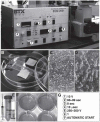Epigenetic reprogramming of somatic genomes by electrofusion with embryonic stem cells
- PMID: 16761720
- PMCID: PMC7122683
- DOI: 10.1385/1-59745-005-7:67
Epigenetic reprogramming of somatic genomes by electrofusion with embryonic stem cells
Abstract
Cell fusion is an approach for combining genetic and epigenetic information between two different types of cells. Electrofusion for generating hybrid cells between mouse embryonic stem cells and somatic cells, which is a type of nonchemically induced and nonvirus-mediated cell fusion, is introduced here as a highly effective, reproducible, and biomedically safe in vitro system. Under optimized electrofusion conditions, cells are ligned and form pearl chains between electrodes in response to AC pulse stimulation, and subsequently adjacent cytoplasmic membranes are fused by DC pulse stimulation. Hybrid cells survive as drug-resistant colonies in selection medium. Cell fusion is a technique that is applied widely in the life sciences. A recent topic of great interest in the field of stem cell research is the successful production of cloned animals via epigenetic reprogramming of somatic nuclei. Interestingly, nuclear reprogramming for conferring pluripotency on somatic nuclei also occurs via cell fusion between pluripotential stem cells and somatic cells. Furthermore, it has been shown that spontaneous cell fusion contributes to generating the intrinsic plasticity of tissue stem cells. Cell fusion technology may make important contributions to the fields of regenerative medicine and epigenetic reprogramming.
Figures


Similar articles
-
Nuclear reprogramming of somatic nucleus hybridized with embryonic stem cells by electrofusion.Methods Mol Biol. 2006;329:411-20. doi: 10.1385/1-59745-037-5:411. Methods Mol Biol. 2006. PMID: 16846007 Free PMC article.
-
Reprogramming mediated by stem cell fusion.J Cell Mol Med. 2005 Apr-Jun;9(2):320-30. doi: 10.1111/j.1582-4934.2005.tb00358.x. J Cell Mol Med. 2005. PMID: 15963252 Free PMC article. Review.
-
Factors and molecules that could impact cell differentiation in the embryo generated by nuclear transfer.Organogenesis. 2017 Oct 2;13(4):156-178. doi: 10.1080/15476278.2017.1389367. Organogenesis. 2017. PMID: 29020571 Free PMC article. Review.
-
Toti-/pluripotential stem cells and epigenetic modifications.Neurodegener Dis. 2006;3(1-2):32-7. doi: 10.1159/000092090. Neurodegener Dis. 2006. PMID: 16909034 Review.
-
Epigenetic reprogramming in embryonic and foetal development upon somatic cell nuclear transfer cloning.Reproduction. 2008 Feb;135(2):151-63. doi: 10.1530/REP-07-0397. Reproduction. 2008. PMID: 18239046 Review.
Cited by
-
Alternative sources of pluripotent stem cells: altered nuclear transfer.Cell Prolif. 2008 Feb;41 Suppl 1(Suppl 1):7-19. doi: 10.1111/j.1365-2184.2008.00484.x. Cell Prolif. 2008. PMID: 18181941 Free PMC article. Review.
-
Cell-cell fusion as a mechanism of DNA exchange in cancer.Oncotarget. 2017 Dec 27;9(5):6156-6173. doi: 10.18632/oncotarget.23715. eCollection 2018 Jan 19. Oncotarget. 2017. PMID: 29464062 Free PMC article.
-
Macrophage traits in cancer cells are induced by macrophage-cancer cell fusion and cannot be explained by cellular interaction.BMC Cancer. 2015 Nov 20;15:922. doi: 10.1186/s12885-015-1935-0. BMC Cancer. 2015. PMID: 26585897 Free PMC article.
-
A Cell Electrofusion Chip for Somatic Cells Reprogramming.PLoS One. 2015 Jul 15;10(7):e0131966. doi: 10.1371/journal.pone.0131966. eCollection 2015. PLoS One. 2015. PMID: 26177036 Free PMC article.
References
MeSH terms
LinkOut - more resources
Full Text Sources
Medical

